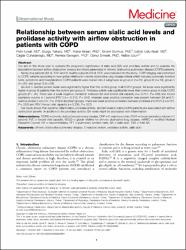| dc.contributor.author | Uysal, Pelin | |
| dc.contributor.author | Teksöz, Duygu | |
| dc.contributor.author | Aksan, Hülya | |
| dc.contributor.author | Durmuş, Sinem | |
| dc.contributor.author | Gelişgen, Remise | |
| dc.contributor.author | Şimşek, Gönül | |
| dc.contributor.author | Uzun, Hafize | |
| dc.date.accessioned | 2023-01-03T06:22:19Z | |
| dc.date.available | 2023-01-03T06:22:19Z | |
| dc.date.issued | 2022 | en_US |
| dc.identifier.citation | Uysal, P., Teksoz, D., Aksan, H., Durmus, S., Uslu-Besli, L., Cuhadaroglu, C., Gelisgen, R., Simsek, G., & Uzun, H. (2022). Relationship between serum sialic acid levels and prolidase activity with airflow obstruction in patients with COPD. Medicine, 101(11). pp. 1-6. https://doi.org/10.1097/md.0000000000028949
| en_US |
| dc.identifier.issn | 0025-7974 | |
| dc.identifier.issn | 1536-5964 | |
| dc.identifier.uri | WOS: 000776240300010 | |
| dc.identifier.uri | PubMed ID: 35356903 | |
| dc.identifier.uri | https://hdl.handle.net/20.500.12900/134 | |
| dc.description.abstract | Our aim in this study was to evaluate the prognostic significance of sialic acid (SA) and prolidase activity and to evaluate the
association between airflow obstruction severity and these parameters in chronic obstructive pulmonary disease (COPD) patients.
Ninety-four patients (84 M, 10 F) and 34 healthy subjects (19 M, 15 F) were included into the study. COPD staging was performed
to COPD patients according to new global initiative for chronic obstructive lung disease criteria which includes pulmonary function
tests, symptoms and hospitalization; COPD patients were divided into 4 subgroups as group A (n=25), group B (n=19), group C
(n=20), and group D (n=28).
SA and C-reactive protein levels were significantly higher than the control group in all COPD groups. SA levels were significantly
higher in group B patients than the control and group A. Prolidase activity was significantly lower than control group in total COPD
groups (P<.05). There was a weak negative correlation between SA and forced vital capacity (r=–0.217, P=.038) and forced
expiratory volume in 1 second (FEV1) (r=–0.210, P=.045), whereas weak positive correlation was present between SA and Creactive protein (r=0.247, P=.018) in all patient groups. There was weak positive correlation between prolidase and FEV1 (r=0.222,
P=.033) and FEV1/forced vital capacity (r=0.230, P=.027).
Our study shows that systemic inflammation, prolidase activity, and SA levels in stable COPD patients are associated with airflow
obstruction severity. In addition to the prolidase activity; SA levels might be associated with inflammation.
Abbreviations: COPD = chronic obstructive pulmonary disease, CRP = C-reactive protein, FEV1 = forced expiratory volume in 1
second, FVC = forced vital capacity, GOLD = global initiative for chronic obstructive lung disease, mMRC = modified Medical
Research Council, NA = neurominadase, PFT = pulmonary function tests, SA = sialic acid, TSA = total SA. | en_US |
| dc.language.iso | eng | en_US |
| dc.publisher | Lippincott Williams & Wilkins | en_US |
| dc.relation.isversionof | 10.1097/MD.0000000000028949 | en_US |
| dc.rights | info:eu-repo/semantics/openAccess | en_US |
| dc.subject | Chronic obstructive pulmonary disease | en_US |
| dc.subject | C-reactive protein | en_US |
| dc.subject | Prolidase activity | en_US |
| dc.subject | Sialic acid | en_US |
| dc.title | Relationship between serum sialic acid levels and prolidase activity with airflow obstruction in patients with COPD | en_US |
| dc.type | article | en_US |
| dc.department | İstanbul Atlas Üniversitesi, Tıp Fakültesi, Temel Tıp Bilimleri Bölümü | en_US |
| dc.authorid | Hafize Uzun / 0000-0002-1347-8498 | en_US |
| dc.contributor.institutionauthor | Uzun, Hafize | |
| dc.identifier.volume | 101 | en_US |
| dc.identifier.issue | 11 | en_US |
| dc.identifier.startpage | 1 | en_US |
| dc.identifier.endpage | 6 | en_US |
| dc.relation.journal | Medicine | en_US |
| dc.relation.publicationcategory | Makale - Uluslararası Hakemli Dergi - Kurum Öğretim Elemanı | en_US |

















